As much of the world moves into winter, many are looking for alternative methods to heat their house. During colder months, there’s a significant spike in electricity due to people’s reliance on heating systems.
Unfortunately, these systems aren’t very environmentally friendly. Most rely on wood and coal furnaces that contribute to greenhouse gas emissions.
At Climatebiz, we explore sustainable off-grid heating methods to determine the most efficient ones. This article sums up 9 alternative ways you can heat your home in a more environmentally friendly manner.
From ensuring you insulate your home well to biomass heating, we explore heating methods that you may not have crossed your mind.
Table of Contents
9 Alternatives Ways To Heat Your House
These alternative ways to heat your home are suitable for sustainable, off-grid, or more efficient living. Most are standard practices for new homeowners as we move to a greener future, while others are less well-known. Either way, they’re great alternatives to coal furnaces, electric heaters, and AC units.
Here are 9 alternatives ways to heat your home:
- passive heating design
- proper insulation
- thermal mass construction
- thermal energy storage
- ground-source heat pumps
- air-source heat pumps
- biomass heating
- biogas boilers
- solar water heating systems
Passive Heating
Passive heating is a broad term encompassing household heating principles and methods without mechanical aid.
You can achieve passive heating through multiple design principles, such as orientating your home in the correct position relative to the sun. Another passing heating method involves building your home with thicker walls — we’ll touch on this later.
Then there are earth ships, aka earth homes. These structures harness passive heating because they depend on the ground around them for heat regulation.
Overall, the concept comes down to increasing heat gain in your home and preventing heat loss. And while you should consider most of these principles when building your home, there are incremental steps you can take to improve your current home.

Source: Passive House Institute
Where Do I Start?
You can start by replacing your window frames with passive window designs. These specialized windows trap heat inside while allowing natural light into your space. In addition, their double-layer glass prevents heat transfer between the inside and outside of your home, regulating your climate better than standard windows.
Related Reading: Best Passive House Windows: Which should you install?
Insulation
Insulation involves material that resists heat transfer. Regulations often require homes to have appropriate insulation installed. Ensuring this will lead to excellent heat retention within your home, keeping your interior cozier.
Most thermal insulation is made from materials with a low conductivity rate, such as cellulose fiber and fiberglass. Therefore, insulation can resist heat differently depending on the material used and the thickness. The measurement of how well the insulation can withstand heat is called the R-Value.
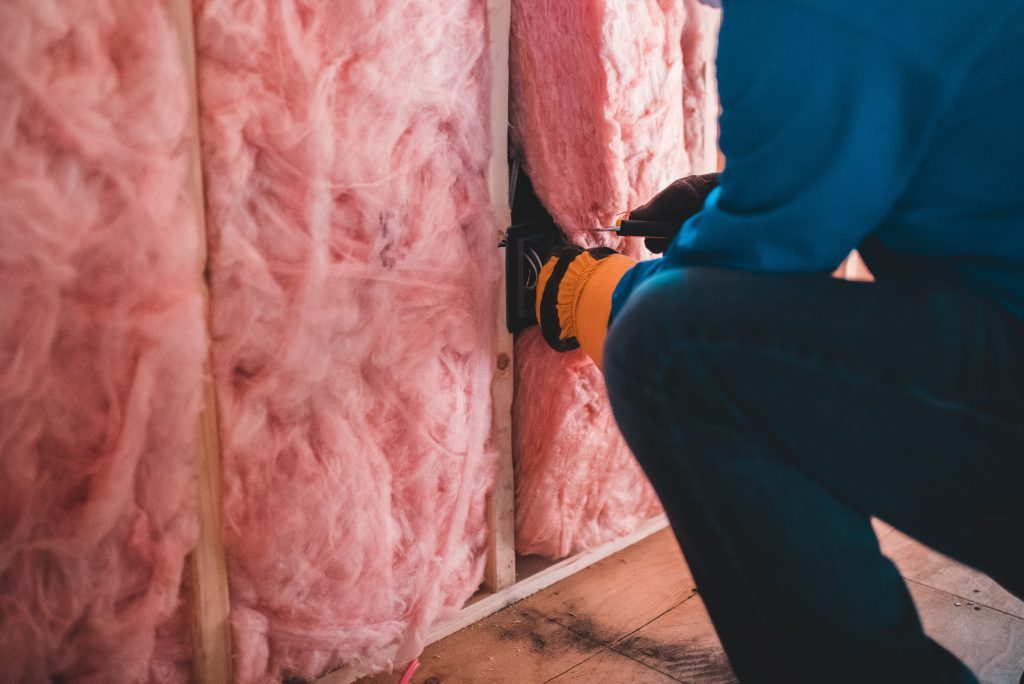
Source: Adobe Stock
If you live in a climate where the temperature doesn’t vary more than 42°F (6°C), you should have insulation with a lower R-Value. In contrast, your home insulation should have a higher R-Value if you live in a colder climate.
For those living in the U.K., the Energy Savings Trust states that having a well-insulated home can save you up to $410 on your energy bill.
In the end, it’s easy to see how insulation is one of the passive design principles out there. With it, you’ll be well on your way to turning your home into a passive house.
Thermal Mass
Thermal mass is a heating technique that has been present throughout history, modernized, and used in our homes. Nowadays, you’ll find homes using thermal mass as a passive heating technique in climates with extreme temperature changes, such as deserts. That said, people living in other climates can also benefit from it.
Thermal mass refers to a material’s ability to capture, store and release heat. For example, a brick wall in direct sunlight will catch and release heat during a cool night. Furthermore, the rate at which a material releases heat is called thermal lag.
Incorporating materials that have thermal mass into the design of your home is a great way to regulate the indoor climate. Such materials include stone, concrete, brick, and rammed earth.
Overall, thermal mass is an excellent alternative to heating your house and keeping it cool during the summer. That said, the thermal mass principle isn’t efficient enough to warm your whole home. Instead, you’ll need to pair it with other passive design principles like those mentioned above.
Thermal Energy Batteries/Storage
Thermal Energy Batteries (TBat) are units designed to store heat efficiently for later use. Think of them as a giant hot water bottle — heat is stored within the battery and slowly released over time.
Like thermal mass, thermal batteries absorb heat on an atomic level, store the energy, and then release it later. As a result, TBats are a great alternative to heating your home.
While there are various thermal batters and storage units, we’re highlighting solar energy thermal batteries. They’re simple yet effective and easy to implement in existing homes.
Solar Energy Storage
This thermal battery charges via solar energy in the form of heat. The ‘battery’ consists of a highly-insulated boiler that contains water or other heat-transferring liquids.
The system heats water and pumps it back into the boiler using solar thermal panels. There, the heated water is stored until it’s needed for radiators or used in heat exchange.
As the water in the boiler inevitably cools, the cooler water is pumped through the system and heated again.
Why Use Solar Energy Storage
While this may seem redundant, many homes would benefit from these thermal batteries.
Using this battery can come in handy if you live in a climate where solar thermal panels aren’t efficient. Water in the boiler will warm up on days when there’s enough sunlight and will be kept warm by the insulation when you need it.
In fact, some thermal batteries are so effective that you can use them seasonally. The batteries capture heat during the summer months and store it until needed in the winter.
Ground-Source Heat Pump
Heat pumps are one of the most efficient alternative ways to heat your house without an AC unit, furnace, or electric heater. Essentially, they transfer heat from one substance to another. Between ground-source and air-source heat pumps, the former takes the cake in efficiency.
Ground-source heat pumps are 72% more efficient than natural gas furnaces. As a result, they are one of the best alternative methods to heat your house because they transfer heat between the earth and your home.
Using long lengths of pipes filled with a heat-transferring liquid such as water, a GSHP absorbs heat from the ground and ‘pumps’ it into your home.
What Is A GSHP Capable Of Doing?
A GSHP can produce 4 units of heat with just one unit of electricity. There are two main types of GSHP systems:
- closed loop systems
- open loop systems
Closed Loop Systems
A closed-loop system uses a heat-transferring liquid that stays within the system’s pipes. These systems are typically placed either horizontally or vertically in the ground alongside your home.
The pipes — located at least 5 feet below the surface — transfer cold liquid from the heat exchange to the ground. The earth’s steady temperature then warms the liquid before being transferred back into the heat exchange.
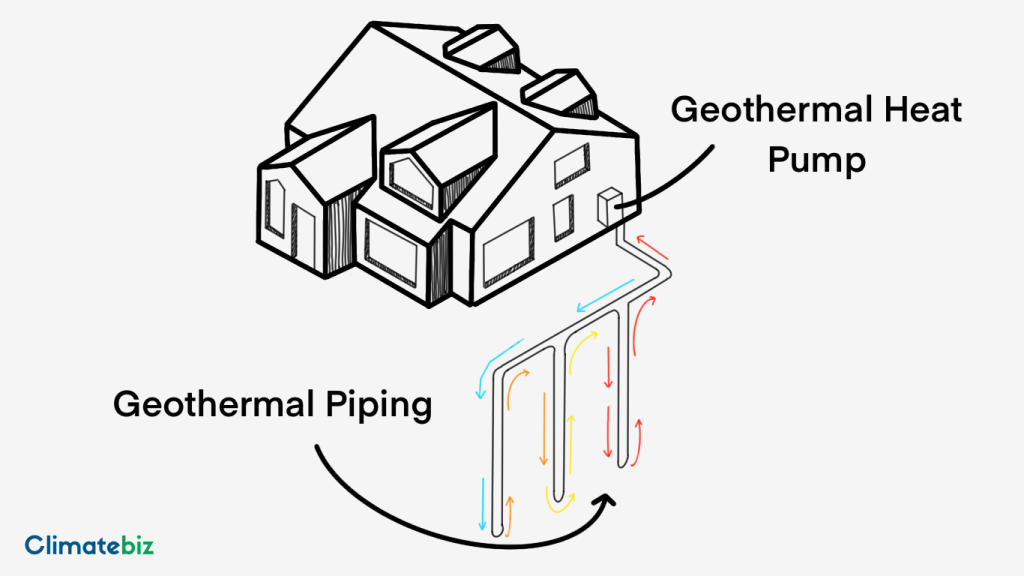
Once in the heat exchange, the hot liquid transfers its heat to an evaporator unit. The heat turns liquid within the evaporator into gas, which travels through a compressor. This process generates enough heat to move through the distribution system and warm your home.
Related Reading: What Is The Cost Of A Ground Source Heat Pump?
Open Loop Systems
The main difference between a closed and open loop system is that open loop systems use groundwater as the primary heat source. If your property includes boreholes or underground water pockets, you can pump the warmer water into your heat exchange.
The same compression process occurs from there, distributing heat throughout your home. Then, as the groundwater in the system cools down, it’s pumped back into the ground to replenish the natural wells.
This alternative to standard GSHP is efficient and works effectively for those with available resources.
You can learn about ground-source heat pumps here or discover how they compare to natural gas furnaces.
Related Reading: Are Geothermal Heat Pumps Worth The Money?
Air-Source Heat Pump
An alternative to GSHP is air-source heat pumps. They work in a similar way, extracting heat from the environment and transferring it to where we need it.
An ASHP consists of three main components:
- two heat exchangers
- a compressor
- an expansion valve
Air is extracted from the outside environment and flows through the system and into a compressor. The compressor forces the air into smaller pipes, heating the air. The air passes against tubing filled with a refrigerant at a low boiling point.
The hot air heats the refrigerant distributed through your home heating system. The refrigerant cools down during the process and returns to the heat pump for the process to repeat.
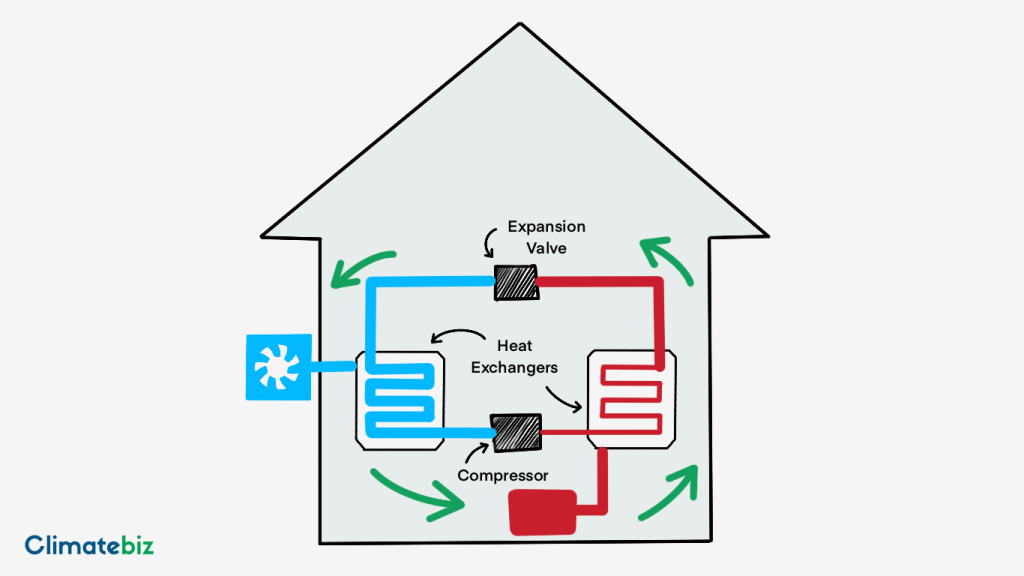
The only downside to air-source heat pumps is that they lose efficiency in frigid climates. For example, you can begin to see efficiency levels drop as soon as the temperature falls below 25°F (-3.8°C).
Biomass Heating
Natural organic materials, such as wood, leaves, wheat husks, and mulch, are known as biomass. This heating process uses these organic materials to generate heat for your home. Not only is this an off-grid heating method, but it is excellent for those that live on larger plots of land with natural woodlands/vegetation.
There are two primary types of biomass heating, each with its advantages and disadvantages. They are:
- Biomass Boilers
- Aerobic Biodegradation Heating
Biomass Boilers
Biomass boilers work like standard boilers and furnaces, except they use biomass instead of coal or electricity. While this offers an alternative method of heating and curbs your carbon footprint slightly, there’s one major disadvantage — you need an extensive stockpile of biomass.
The accompanying diagram shows that biomass such as recycled wood chips, hay, dried leaves, and wheat husks are fuel sources. However, the organic material acts more like tinder and burns significantly faster. Therefore, you will need a substantial amount of biomass to fuel your boiler.
Still, if you’re a farmer or live on a large plot of land, using your organic waste as a fuel source is an excellent alternative to throwing it away.
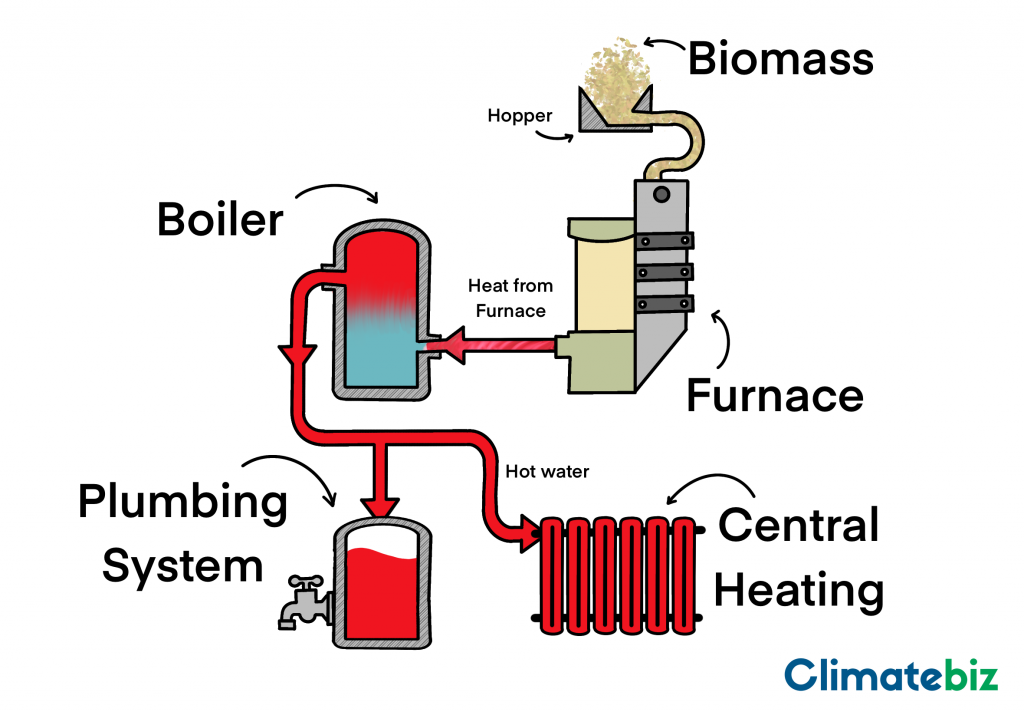
Aerobic Biodegradation Heating
Like heat pumps, this method transfers heat from one material to another, warming your home. However, this technique is unique as it takes advantage of aerobic biodegradation.
Simply put, this is the process in which organic matter decomposes while exposed to air. Microorganisms break down organic matter (such as wood chips and leaves), which generates enough energy to heat water.
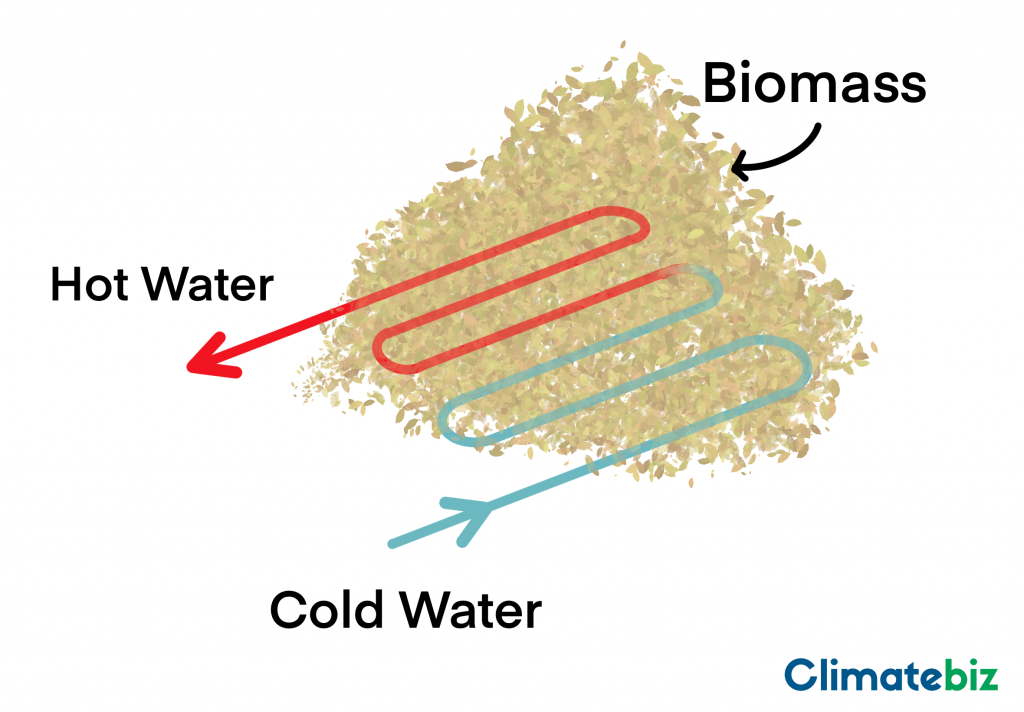
In fact, one study proved that temperatures within a heap of biomass could reach 158º F. Therefore, having a system that runs cold water through the heap of biomass connected to a heat exchange can create an effective system.
However, this process requires a large amount of biomass and the right conditions for the biomass to decompose. Additionally, the process heavily depends on the season, influencing the system’s efficiency.
Biogas Boilers
Biogas is a fuel produced from the degradation and fermentation of organic matter such as agricultural waste, manure, and food waste. The gas consists of various gases, mainly methane, carbon dioxide, and hydrogen sulfide.
Organic waste is placed into a large tank where the matter decomposes and ferments. The gas from the process is collected and used to heat a boiler, which heats your home.
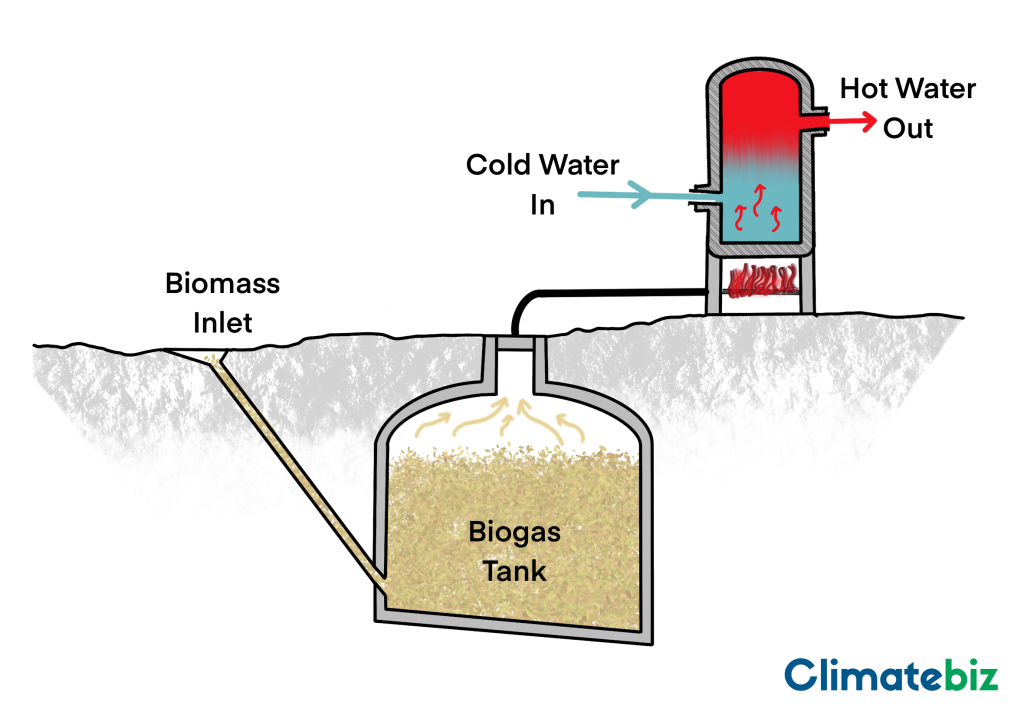
Biogas boilers have an efficiency of 80% but can reach up to 90% depending on the organic matter. This fuel source is fantastic, with many impoverished countries relying on it for cooking and heating.
These boilers are excellent for larger plots of land, community lots, and farms with livestock or much green waste. You can toss everything from inadequate crops to manure into the tank and use it to heat your home.
Not only is it an effective method, but it also decreases your bio-waste and environmental impact and acts as an off-grid heating method.
Solar Water Heating Systems
Solar energy is a great alternative to heat your house if you live in a suitable climate. By placing solar thermal panels on your roof, you can create a system that distributes heat throughout your home using a heat exchange.
Additionally, you can have the hot water run through pipes cast into your concrete floors, creating solar underfloor heating.
Solar Water Heaters
Solar thermal panels are devices you can use to heat water and other fluids via solar energy. Simply place these panels on your roof and expose them to the sun.
Cold water flows through the pipes and heats up through the sun’s radiation. The hot water is pumped into a boiler or geyser, where it’s stored and used.
Solar geysers can be a direct hot water supply to your home or a thermal battery, as previously discussed. Alternatively, the hot water can flow through a heat exchange, achieving higher temperatures.
What Is The Most Environmentally Friendly Way To Heat Your Home?
Ground-source heat pumps are the most effective alternative to heat your house. Here’s why:
We know that energy cannot be created or destroyed, only transferred. This is not the case with heat. Unfortunately, no matter the process, heat energy transfers from one substance to another, often requiring input and leaving an unwanted byproduct.
Keeping this in mind, the best alternative environmental method to heat your home would generate the least amount of unwanted byproducts.
However, we must recognize that efficiency comes into play. For example, an inefficient solar heater will need additional units or heaters. Or, an inefficient biomass boiler will lead to more CO2 emissions from burning more fuel.
Therefore, ground-source heat pumps are the most environmentally friendly way to heat your home in 2022.
If that doesn’t convince you, the EPA has received the Most Energy Efficient 2022 Energy Star award for multiple geothermal heat pumps.
Final Thoughts
As you can see, alternative ways to heat your house exist — there’s certainly more than one way to skin a cat.
While some require larger properties, such as biogas boilers, others are compact, meaning you can install them anywhere (passive design & insulation).
In summary, installing a ground-source heat pump is the best alternative way to heat your house. Methods such as passive design, solar heaters, and biogas boilers come in second.
Ultimately, deciding which alternative way to heat your house is best can be daunting, especially if the concept is new to you. That’s why we made sure to include as many links as possible to related articles — allowing you to explore each method in more detail.
If you have any further questions or insight into alternative ways to heat your house, contact one of our experts on Twitter or in the comments below. We’ll answer your questions to the best of our ability and point you in the right direction.

